It’s a beautiful sunlit morning at Panama Flats Park and I’m out on my very first bird walk. As I’m making my way along the path, I look up over the marsh and see a dozen birds swooping in wide arches in a beautiful display of precision and technique. I look to my friend who’s knowledge of birds far exceeds mine, with a smile on her face she says the name of my first species, Barn Swallow.
Introduction to the Barn Swallow
Description
The Barn Swallow (Hirundo rustica) is one of eight members of the Order Passeriformes and Family Hirundinidae (All About Birds). This swallow has a slender body, broad shoulders, long pointed wings, and a forked tail with a white band. The approximate measurements of this lovely bird, are 17cm for length, 38cm for wingspan, and weighs around 19g (Sibley).
Within this species are six subspecies that vary geographically. In North America, the American subspecies is the only one that breeds, therefore, it is the one I will focus on in this blog (All About Birds).
Barn swallows have dark blue backs, wings, and tails, and a rusty orange chest, throat, and forehead. Their belly will range from cinnamon, orange, tawny, to an almost white colour. Females are almost identical to males; however, they display paler/white underparts and the tail isn’t quite as long. Juveniles exhibit deep blue backs and rusty/orange faces and necks, like the adults; however, they have lighter underparts similar to the female and their tails are also shorter (All About Birds).
Although the Barn Swallow resembles the other swallows, it is its forked tail that will set it apart and make this species so unique. This bird has a maximum reported life expectancy of 8 years with 4 years being the average (COSEWIC).
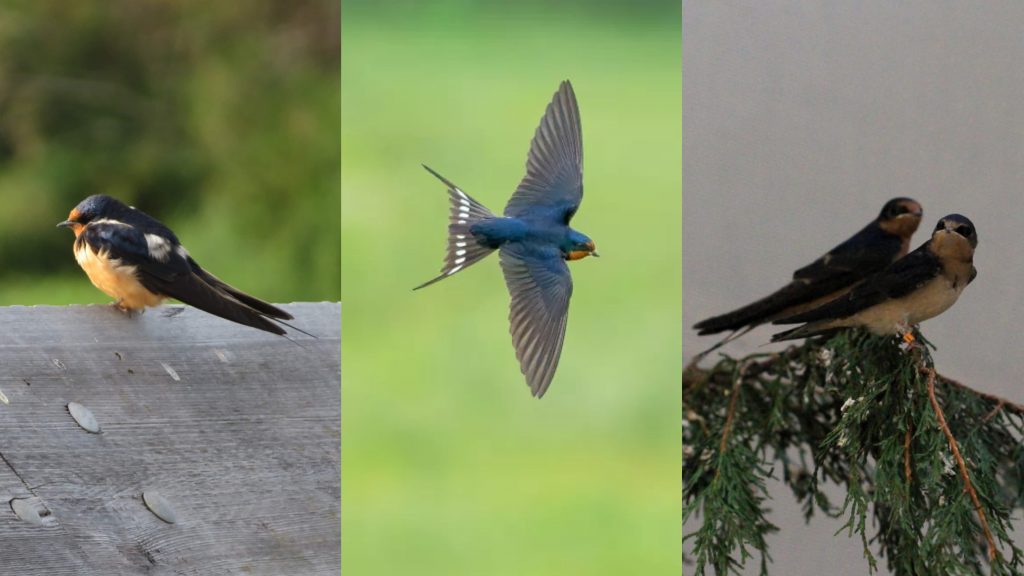
Vocalization
The song lilts (rises and falls) with a squeaky husky quality similar to call notes, which are often interrupted by dry, creaking rattles. (Sibley)
The call is a husky short vit or vit-vit, and when alarmed it will call a sharper and stronger vit-VEET or si-VLIT (Sibley)
Ian Cruickshank)
Distribution and Habitat
Barn Swallows are the most widespread of all the swallows, as they are found across the globe. They range as far north as Svalbard, a Norwegian archipelago, to Europe, Asia, Africa, North and South America, and as far south as the South Shetland Islands of Antarctica (eBird and COSEWIC).
Barn swallows are found in Canada in the summer during their breeding season and head down to Central and South America for their non-breeding season during the winter (All About Birds).
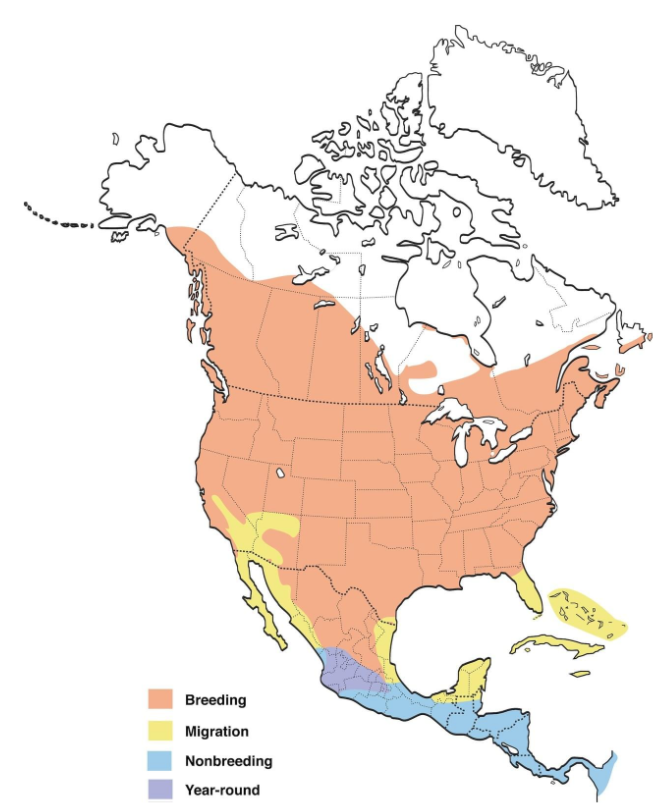
Figure 3: North American Barn Swallow Distribution (Photo from All About Birds)
Along with its widespread distribution, its habitat is also diverse. Before European colonization, barn swallows would find a home in caves, holes, crevices, ledges, and in cliff faces; however, since colonization, they are predominantly found in man-made structures such as barns, eaves, under bridges and docks, or other similar locations. They can be spotted flying in open or semi-open land, fields, farms, marshes, lakes, coastal waters, and suburban parks. Places it will avoid are the dry country and unbroken forest (Audubon).
Cultural significance:
The swallow tattoos (based off of the Barn Swallow) are a common design due to its origin from sailors who would get a swallow tattoo on their chest for every 5000 nautical miles, and once they got 10,000 nautical miles, they would get another on the other side. Those that had one swallow or even better, two swallow tattoos would be considered very experienced sailors and receive a greater amount of respect. Swallows also have significance for sailors in folklore, the belief being that if the sailor were to drown, their soul would be carried away by the bird (Ornithology)
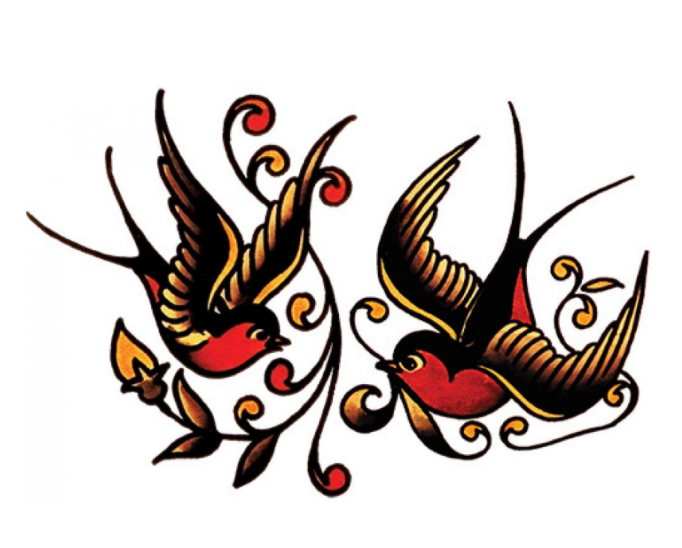
Flying High
A distinguishing feature of swallows would be their infamous flying, broad pointed wings that pull back at the end of each stroke, allowing them to swoop and dive acrobatically in the air. This typical flight pattern has made this family stand out amongst others (All About Birds).
Barn swallows in particular fly lower than most other species of swallows, and are commonly observed hugging the ground or water surface while in flight (All About Birds).
One of the reasons these lovely birds fly in such mesmerizing patterns has to do with their method of eating. Unlike many ground-foragers that search for invertebrates, seeds, and other fallen items, these birds will catch their food in mid-air. Their diet consists of a variety of flying insects including flies, beetles, wasps, bees, winged ants, and true bugs. Sometimes they will expand their choice to include moths, damselflies, grasshoppers, and even a few spiders and snails. Very rarely will they eat berries or seeds (Audubon).
Courtship, Breeding, and Nestlings
Like every species on earth, not only do they eat, but they also mate. Although this species is socially monogamous, polygamy is not uncommon. Barn Swallows will participate in aerial chases during their courtship, males will show off the length of their tail and sing to their lady friends. The females will typically pick the male based on who is most vibrantly coloured (Audubon and Hinterland). Once they become a mated pair, they will perch close together, touch bills, and even preen the other’s feathers. Females breed for the first time when they’re one year old, whereas some males will remain unpaired until they’re two years old. Pairs that have nested together before and were successful could remain together for several years (Audubon).
The barn swallows are ready to nest about 5-14 days after the spring arrival. The male and female will explore possible sites by flying up and hovering over a certain location, then assessing other options, before coming to a conclusion on where they want to nest. Man-made sites are preferred, such as eaves, rafters, cross beams in barns (hence their name), sheds, stables, underneath bridges, wharves, and culverts. It isn’t uncommon for them to use a nest from a previous year, pending on if it’s infected with parasites such as mites (All About Birds and Audubon).
When the spot is found, both the male and female will work on building the nest, which can take about 6-15 days on average (All About Birds). Studies have found that short-tailed males will contribute more to building nests than males with long tails (Teglhøj). They mix grass stems and mud together to create pellets which are first constructed into a small shelf for them to sit on, then the sides of the nests are built. Nests can be a completely circular cup or a semicircular half cup with a 3-inch diameter and 2-inch depth. After the walls are done, the nest is lined with grass first, followed by feathers. It isn’t uncommon for these swallows to be little thieves and take lining materials from a neighbour’s nest. If the parents chose to reuse a nest rather than go through the hassle of making one from scratch, they will need to do some renovations first, which requires cleaning out the old feathers and adding new mud to the rim of the nest. Now that the nest is all ready, it is time to have some chicks (All About Birds and COSEWIC).
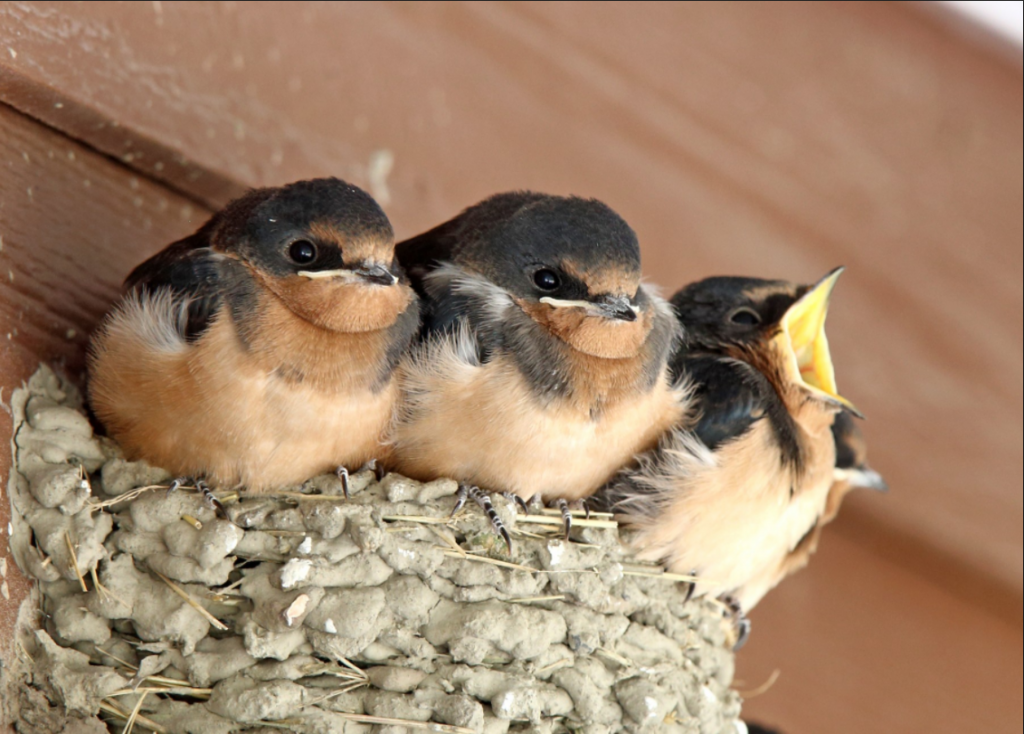
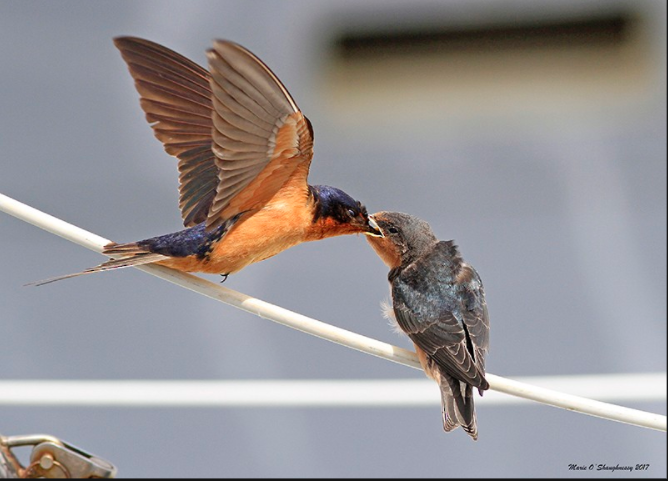
Swallows have one to two brooding events a year, one being more common in the northern range of Canada. During each brooding event they will have a clutch size of 3-7 eggs, with the first event usually have more than the second. This requires about 12-17 days of incubation, followed by 15-27 days for the nesting period (COSEWIC). Swallows like most songbirds are altricial, which means that when they hatch they are fairly underdeveloped, eyes closed, almost naked of feathers, and still require a lot of care from their parents for protection and resources (All About Birds).
The males will guard their territory and chase away other males aggressively if they get too near. They can even grab the aggressor with their feet and tumble to the ground. Although very small, these creatures will stop their own quarrels and join forces to gang up on predators like hawks, gulls, or grackles that get too close to these precious nests (All About Birds).
Conservation
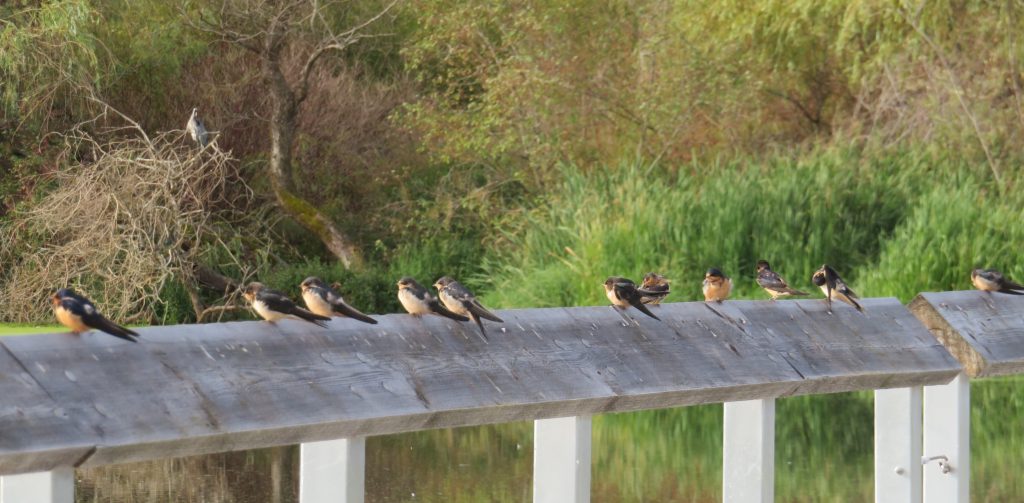
In 2011 the Canadian population of breeding pairs was 2.45 million (4.9 million mature individuals). Despite being common and widespread, the Breeding Bird Survey (BBS) between 1970-2009 shows that there is a statistically significant decline of 3.6% per year in Canada. This corresponds with an overall 76% decline over the 40 years, which began in the mid-1980s . In the last decade of the survey there was an overall decline of 30%, which is enough to be considered threatened under the Committee on the Status of Endangered Wildlife in Canada. Regardless of this decline, the distribution and numbers of this species are admitted to be greater than before the European settlement, because this species was able to utilize man-made structures for their own benefit. At the global level, the Barn Swallow is considered ‘Least Concern’ according to the IUCN Red List (COSEWIC).
Causes for this decline are still undetermined; however, possibilities include habitat loss and degradation of breeding grounds, large-scale changes in insect prey, climate change, interspecific competition for nest sites from invasive species, parasitism, and human persecution (COSEWIC).
Not so fun fact: The killing of the Barn Swallows for hat-making led to a naturalist by the name of George Bird Grinnell, to write 1886 Forest & Stream, an editorial addressing the waste of birds lives. This essay helped lead to the founding of the first Audubon Society (All About Birds).
Recent Research
As I mentioned earlier, the Barn Swallow, despite its large distribution is on the decline. Research by Peter Györkös Teglhøj a biologist from Denmark set out to determine one way to conserve this beautiful species through the use of artificial nests. In Denmark, the Barn Swallow population decline is about 30% since 1976, which compared to our 30% decline in ten years is not quite as significant but still alarming. There is a positive correlation in the presence of livestock, cattle in particular, with the size of breeding colonies. Between 1990-2006 there was a 61.2% decline in cattle farms which has lead to limited access to appropriate nesting sites in rural areas. This has forced the swallows to find habitats in towns and suburban areas. Teglhøj predicted that artificial man-made nests would help the reproduction of Barn Wwallows. As mentioned earlier Barn Swallows will sometimes reuse old nests to reduce the time and energy it would take to make one from scratch; however, reusing old nests may result in ectoparasites being spread to the new mating pair, or even worse, to their nestlings (COSEWIC and Teglhøj)
Teglhøj provided the Barn Swallows with 176 artificial woodcrete nests in 77 breeding sites, around the urban town of Svendborg, Denmark. These nests were placed in typical nest locations on walls or beams close to the ceiling. Most of them were placed inside buildings, though some were placed under eaves outside. The artificial nests were shaped as open cups just like natural ones. Unlike natural nests, these are screwed into the walls to be resistant to destruction and demolition by other birds or cats. After some careful observations over time, it was found that natural and artificial nests were robbed and/or damaged the same amount, thereby showing that both have equal success against predation. Another factor that was discovered is Barn Swallows that used artificial nests over natural or re-used nests had greater mean clutch sizes for both the first and second clutch (Teglhøj).
The results of the study suggest that the time used to build nests may directly influence the phenology for both the first and second clutch. Earlier laying dates correlated with larger clutches and more fledglings potentially influencing the overall reproductive success and fitness of the individuals (Teglhøj).
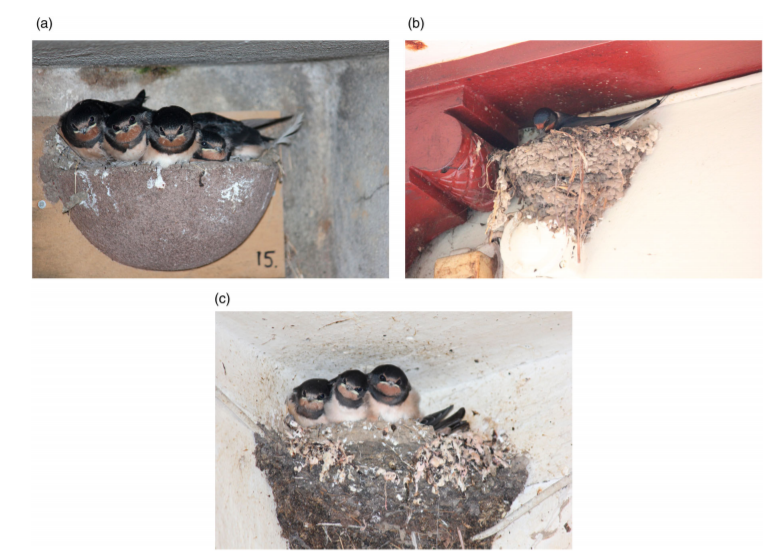
Concluding Thoughts
The next time you see the mesmerizing flight of a swallow, make sure to look for the contrasting colours as well as the distinctive tail feathers: you will most likely have a Barn Swallow. This little species who has found a way to live so close with humans around the entire globe, has found its way into my heart, and hopefully into yours too.
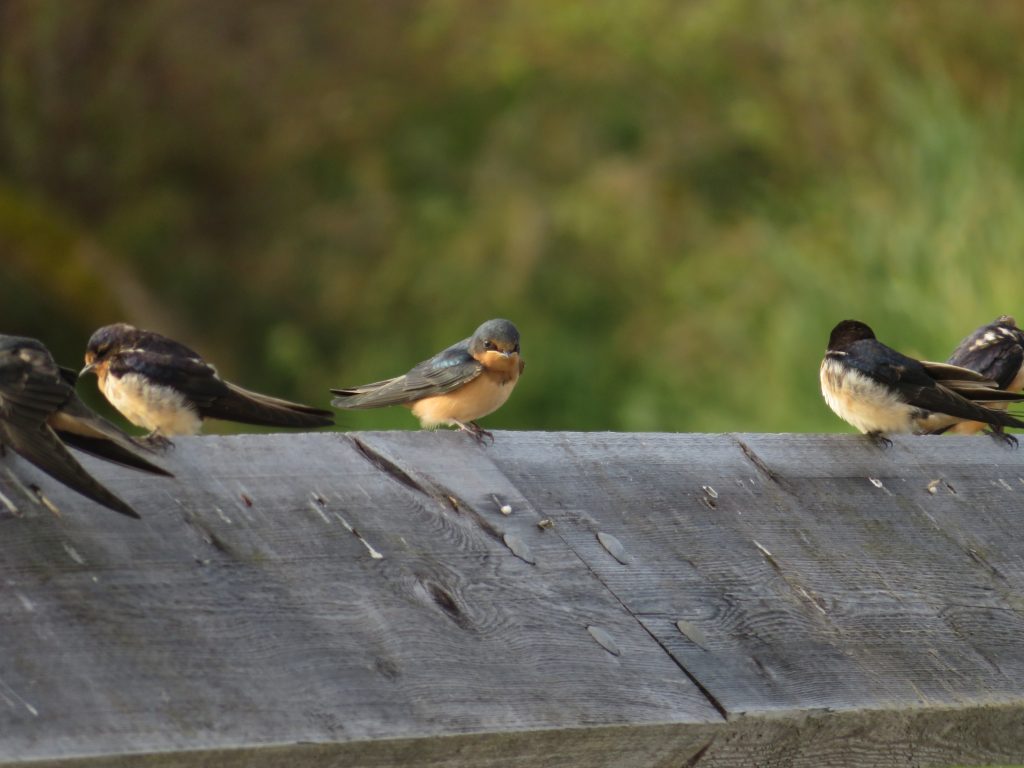
Literature Cited
Sailor Jerry. https://sailorjerry.com/en/tattoos/ (accessed Nov 20, 2020)
Hi Eden!
Interesting read, I loved your photos! I was wondering if you had any more information on how the lore with sailors came about. Perhaps the reason why they chose barn swallows as opposed to a seabird or something?
Julia
Hey Julia!
I’m glad you liked it. According to some sources I found, Swallows have significance in the ancient past such as in Greek and Roman mythology. In ancient Greece the swallow was associated with Aphrodite and was believed to bring happiness and good luck. Deities were supposedly able to change their form into a swallow. In Christianity the swallow is associated with the incarnation of Jesus and his rebirth.
There was even belief that the swallows which appeared out of nowhere in the middle of the ocean had the ability to sleep under it. Seems silly that people would believe that but they did. The thought could be that if a bird has the ability to sleep under the ocean, then it had the ability to tame this ocean.
Although I wasn’t able to find out the exact reason it came about in sailor lore, my belief is that it extended from these beliefs and myths
I hope that answer helps 🙂
Hi Eden,
Really enjoyed the blog! As a new birder you really never forget some of the first times you see a bird, and I could tell that you had such a great admiration for the BARS. I thought the history behind sailors and swallow tattoos was very interesting. You mentioned how when building nests, short-tailed males help the females more. Why do you think this is? I’m not sure if there has been research done to answer this but it’s a very interesting trend. Hopefully this breeding season we will have many Barn Swallows to admire!
Hi Keely,
I’m so glad you liked it! I’m not completely sure the exact reason but an article I read mentions how males with long tails have access to higher quality mates and high extrapair copulation success. This could mean that males that are more desirable have more females that like them, and this leads to greater extrapair copulations. If the male is off cheating on the female, then he would have less time to helping building the nest.
I absolutely agree, I cannot wait for them to return, they’re just wonderful.
Hi Eden
I loved your blog, especially your video/pictures! Super cute! Barn Swallows have such interesting colouring too. The cultural significance part was really neat. It’s funny how the sailors chose a swallow instead of a seabird when they spend all their time at sea like Julia said. Do you know why Barn Swallows choose human-made structures to nest in over natural structures? I’ve always wondered what made them decide to switch from what they’ve been nesting in for thousands of years.
Fantastic blog!
Jenna
Hi Jenna,
Sorry it took so long to answer your question. My hypothesis is that as their natural habitats were being invaded upon they had to find something that would substitute their nesting sites. Human made structures may have provided them that alternative and by being one of the earlier species to take advantage of this they have their on sort of niche that would set them aside from other species. This could have led to higher rates of survivorship. An article I read about Barn Swallows suggests that they evolved coincidingly along with humans and the species could have experienced adaptive radiation. I hope this sort of helps answer your question. 🙂
Hey Eden,
That was an incredibly interesting blog, I’m sad that I’ve never seen a Barn Swallow (or any Swallow), but I’ll keep my eyes (and bins) peeled this summer for those gorgeous lookers. Video 5, the super slow motion flying/feeding of the Barn Swallow was actually crazy! The way they maneuver in the air is exquisite. Is the Barn Swallow just feeding on flying insects that are landed on the water?
As for Barn Swallow decline, did you find anything about them being exposed to insecticides. And, if so, are there any hypotheses about direct toxic effects?
Thank you again for the interesting read!
James
Hey James,
I’m so happy you think they’re interesting too! The Barn Swallow will feed on insects that are in the air as well as those on the water. Because they’re found so often on farmland and with the use of insecticides being used so often it is a very likely factor in their decline. A study in the Netherlands found that neonicotinoids which have been studied to affect the bee population also has impacts on birds such as starlings, sparrows, and swallows. The decline in food sources would lead to less food for these swallows. This could also affect their breeding season because if there is not as many insects to feed their chicks then less chicks may survive. It could be possibles that since Barn Swallows fly so close to the ground to search for insects they can experience first-hand the affects of these toxins which could kill them.
Hi Eden,
Super cool blog! I love watching those little guys zoom around, and even better in slow motion! Do you know if there are any instances of hybridization between Barn Swallows and other Swallow species such as the Cliff Swallow, seeing as they’re pretty similar? Or does their habitat and behavior isolate them from one another?
Cheers,
Brae
Hey Brae!,
Super good question I never considered that until now. After looking at a study in the 1980s there has been previous instances of hybridization between the Cliff and Cave Swallows. Cave Swallows were more likely indicated to hybridize than the Cliff Swallow. At the same of the study it was stated that hybridization occurred recently which indicates that hybridization has occurred for at least 40 years. I wasn’t able to find distinct reasons why this would happen, and there wasn’t an abundant amount of information about the hybridization which leads to me to believe that it isn’t an often occurrence.
Hi Eden,
Great blog! This is a really cool species, and it’s great you had the chance to take your own photos. They are definitely in my top 6 favourite local swallows;) I also have a special love for swallows. I also appreciate the cultural bit about tattoos… very cool!
I love the white spots in their tail. Did you come across anything in your research suggesting that more/bigger white spots are preferred? I have heard that in other species, so I’m curious about BARS!
Thank you for sharing your love of these beautiful BARS!
Cheers,
Sam
Hi Sam,
I’m so glad you liked my blog! I’m sorry it took so long to reply but I have an answer. The white spots on the tail feathers is positively correlated with the feather length. Long-tailed males may signal the quality of their feathers by the presence of large white spots with no damage from parasites. This is because a type of parasite, called Mallophaga, prefers the white spots and will make holes in the feathers when feeding. Male BARS with large white spots that lack holes would indicate that they have no parasite damage which the females would favour. Therefore, the white tail spots seem to be a signal for phenotypic quality.
Thanks Eden – great presentation!
Thank you so much 🙂
Hi Eden!
Lovely blog, these guys are so beautiful! We had a nest in the rafters of the barn so I got to see some in their nest this summer, they were very cute! I love the video you took at Swan Lake, I’ve never seen so many at once. It’s interesting that there are 6 subspecies of Barn Swallow and only one breeds in North America. Did you find out anything about the range of the other subspecies and if they have any overlap with the subspecies that breeds here? It would be interesting to know where the other subspecies breed.
Thanks for the super interesting blog,
Haley
Hey Haley, I accidently sent that without answering your question. The ranges of the other subspecies is quite spaced out. I have summarized the ranges and as you can see there is some overlap. As well there has been cases of hybridization between the H. r. gutturalis and H. r. tytleri.
• H. r. Rustica is the Eurpoean subspecies that has a large range. It can breed in Europe and Asia, as far north as the Artic Circle, south to North Africa, the Middle East, and east to the Yenisei River
• H. r. transitiva breeds in the Middle East from southern Turkey to Israel and some birds winter in East Africa.
• H. r. savignii, would be the Egyptian subspecies
• H. r. gutturalis, the east Asian subspecies, breeds in the central and eastern Himalayas however the primary breeding range is Japan and Korea. This subspecies will typically spend the winter across tropical Asia as well there have been increasing numbers in Australia.
• H. r. tytleri, breeds in central Siberia south to northern Mongolia and winters from Bengal to Thailand and Malaysia.
H. r. erythrogaster, the North American subspecies which I have covered in this blog breeds from Alaska to southern Mexico, then migrates down to Central and south America.
I’m unsure why there is only one subspecies in the America’s whereas the other five are all condensed to that side of the world. It would definitely be something worth looking into
Sorry for the heaps of information but hopefully it answers everything
Hey Eden,
Awesome blog post, I really enjoyed reading it! There are barn swallows in the barn of my horse and they fly in and out when I’m in the hallway and it scares me every time, they’re so fast! And they poop a lot so I’m prepared to one day get hit.. Also I loved the tattoo tidbit, I find myself always looking at people with swallows and wondering if they have actually travelled enough miles to earn it. Most of my question you’ve answered already in previous comments. I was just wondering if they’re your favourite species and if you’ve gotten to work closely with them?
Thanks,
Kirsten
Hi Kirsten!
I loved your little history with Barn Swallows, thank you for sharing. I volunteered at a wildlife rehab this past summer and we had a couple BARS come in which were orphaned. I got to watch them grow from tiny little featherless dinosaur looking things, to fully feathered beauties. They definitely helped in my choice for this blog. It’s really hard to say if they’re my favourite as I have a great love for the Wrens; however, they’re definitely in my top 5.
Hi Eden,
Great blog! I loved learning a bit more about barn swallows, they were one of my favorite birds to spot as a child when I lived in Alberta. It makes me sad to think that their populations are decreasing so much in Canada, do you know if we have any policies/programs in place to help them out? I also loved the learning about the pre-made nest strategy in Denmark! Do you know if we can buy ‘nest boxes’ that would be attractive for them to use (kind of like an intermediate between the man made nest and a rafter)?
Cheers,
Madi
Hey Madi,
Barn Swallows along with their nests and eggs are protected under the Migratory Birds Conservation Act 1994 and related provincial legislation governing native species of migratory birds. Also in Canada, the suitable breeding habitat for Barn Swallows is on private land, this cannot be protected by the government. There are policies which are put in place for birds in general in Canada but I wasn’t able to find anything that specifically targets BARS.
I tried to find nest boxes that are intermediate between a man-made nest and a rafter however the only thing that came up was the same nest boxes used by tree swallows. Websites I found just mentioned placing a nest box, in the shape of a typical house or in a cup shape, on vertical wall near a mud and food source. I couldn’t find any suppliers in Canada that had semi-artificial nests unfortunately.
Hey Eden,
I enjoyed your post! When I worked at Long Point Provincial Park we always had a barn swallow nest attached to our office building. They became my second species to identify (my first being the Red-winged Blackbird, my chosen blog species). I was always impressed by how closely they would fly to catch insects in the marsh and open fields, plus the adaptation to thrive on man-made structures is just neat!
I was wondering what other kinds of parasites might endanger Barn swallows, and if you know of any specific techniques they use to identify/deal with said parasites?
Cheers,
Kiera Brown!